Case Study: Uzbekistan's Saiga Antelope Preservation and Challenges
VerifiedAdded on 2023/06/09
|11
|3599
|491
Case Study
AI Summary
This case study examines the preservation of the Saiga antelope, a rare species found in Uzbekistan, through the lens of sustainable development. The study highlights the threats to the Saiga population, primarily from poaching driven by the demand for their horns in traditional medicine. It reviews existing literature on sustainable development and animal conservation, focusing on Uzbekistan's efforts to protect the Saiga. The analysis employs the nested sustainability model, considering economic, social, and environmental factors. It evaluates the effectiveness of current preservation programs, including community participation initiatives and anti-poaching measures. The study finds that while some efforts have been made, such as increased penalties for poaching and community-based projects, they may not be sufficient to ensure the long-term survival of the Saiga. It emphasizes the need for stricter regulations, law enforcement, and international cooperation to combat trafficking and protect the Saiga's habitat, in order to improve current conservation strategies and ensure the species' survival. Desklib provides a platform to explore similar case studies and access study tools for further research.
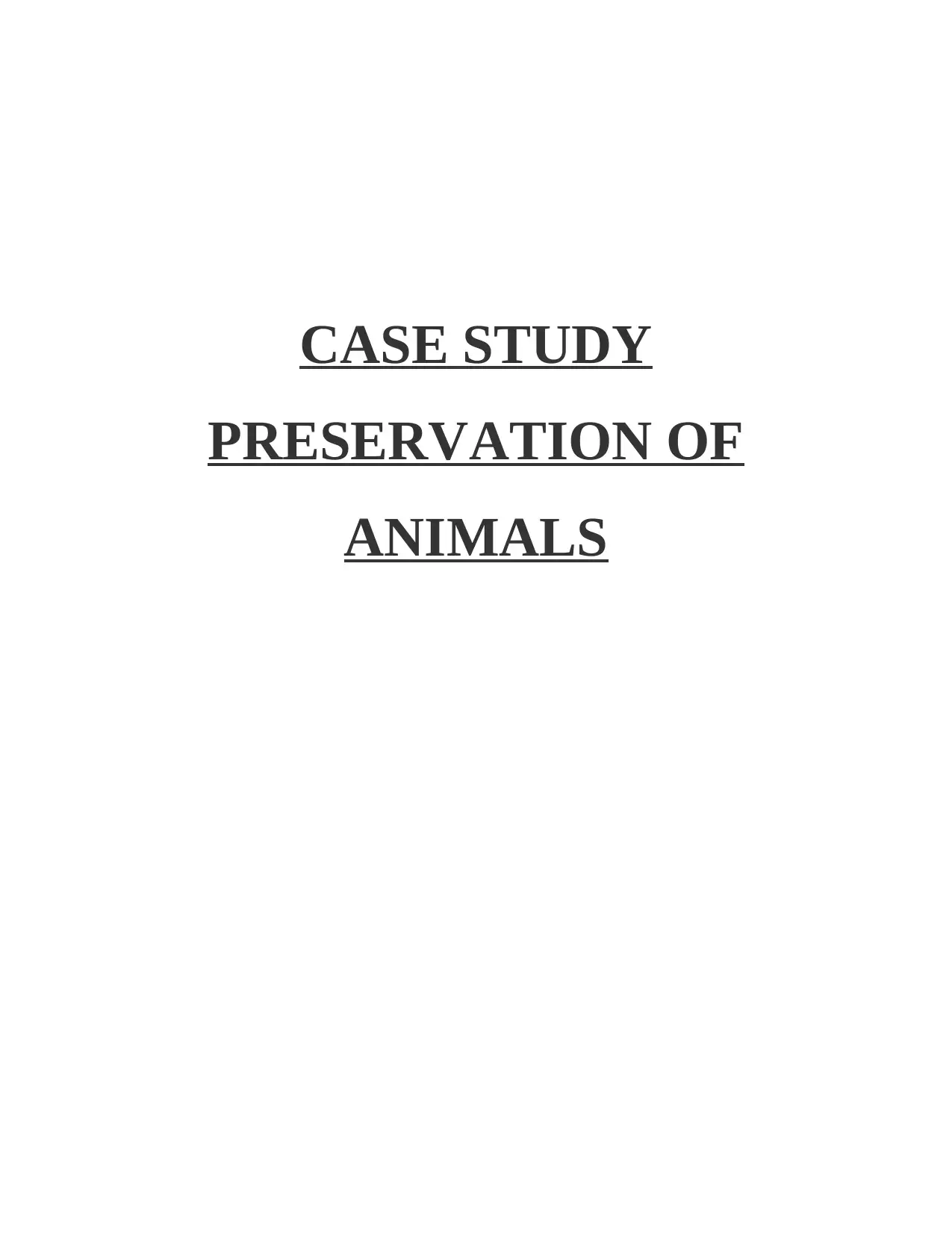
CASE STUDY
PRESERVATION OF
ANIMALS
PRESERVATION OF
ANIMALS
Paraphrase This Document
Need a fresh take? Get an instant paraphrase of this document with our AI Paraphraser
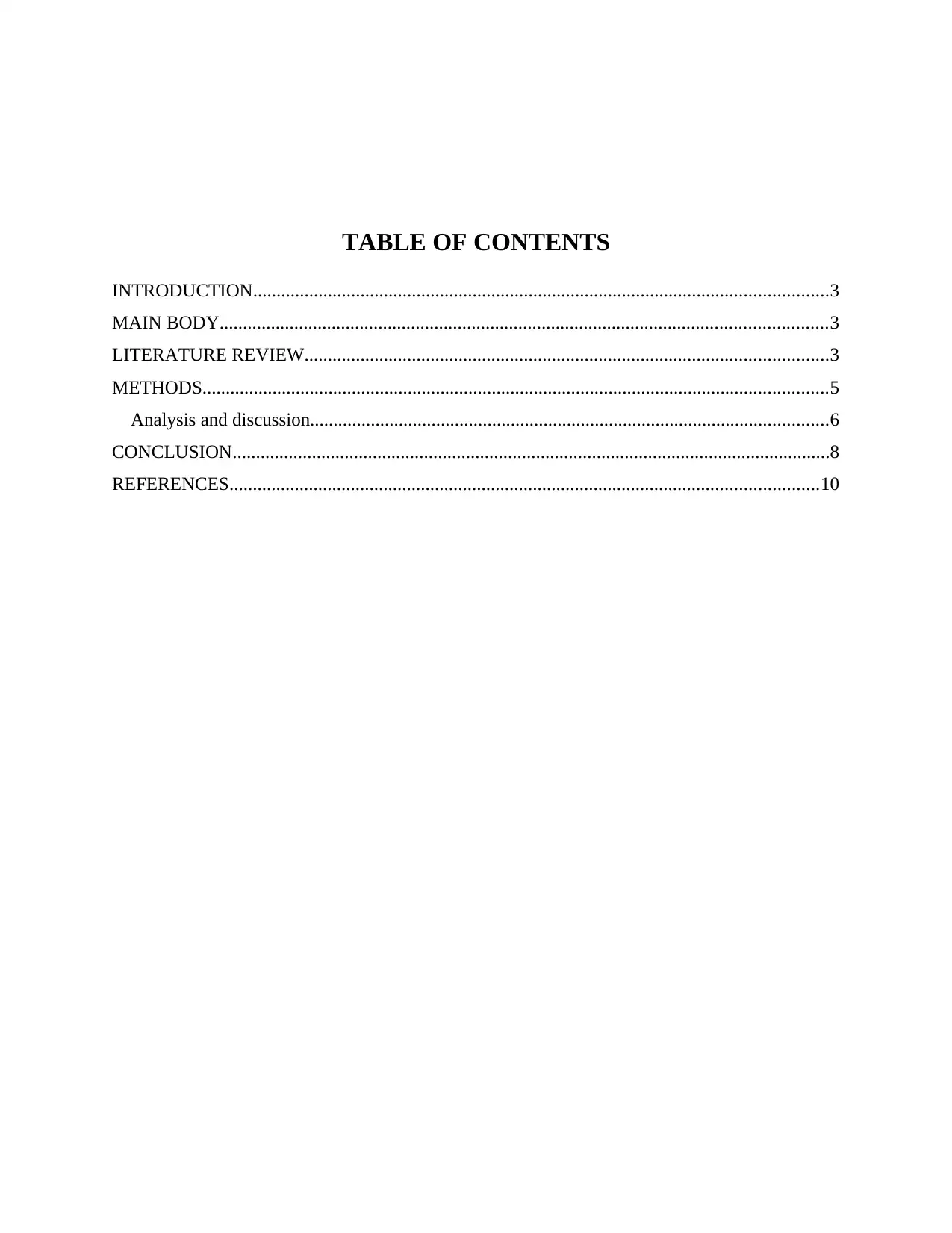
TABLE OF CONTENTS
INTRODUCTION...........................................................................................................................3
MAIN BODY..................................................................................................................................3
LITERATURE REVIEW................................................................................................................3
METHODS......................................................................................................................................5
Analysis and discussion...............................................................................................................6
CONCLUSION................................................................................................................................8
REFERENCES..............................................................................................................................10
INTRODUCTION...........................................................................................................................3
MAIN BODY..................................................................................................................................3
LITERATURE REVIEW................................................................................................................3
METHODS......................................................................................................................................5
Analysis and discussion...............................................................................................................6
CONCLUSION................................................................................................................................8
REFERENCES..............................................................................................................................10
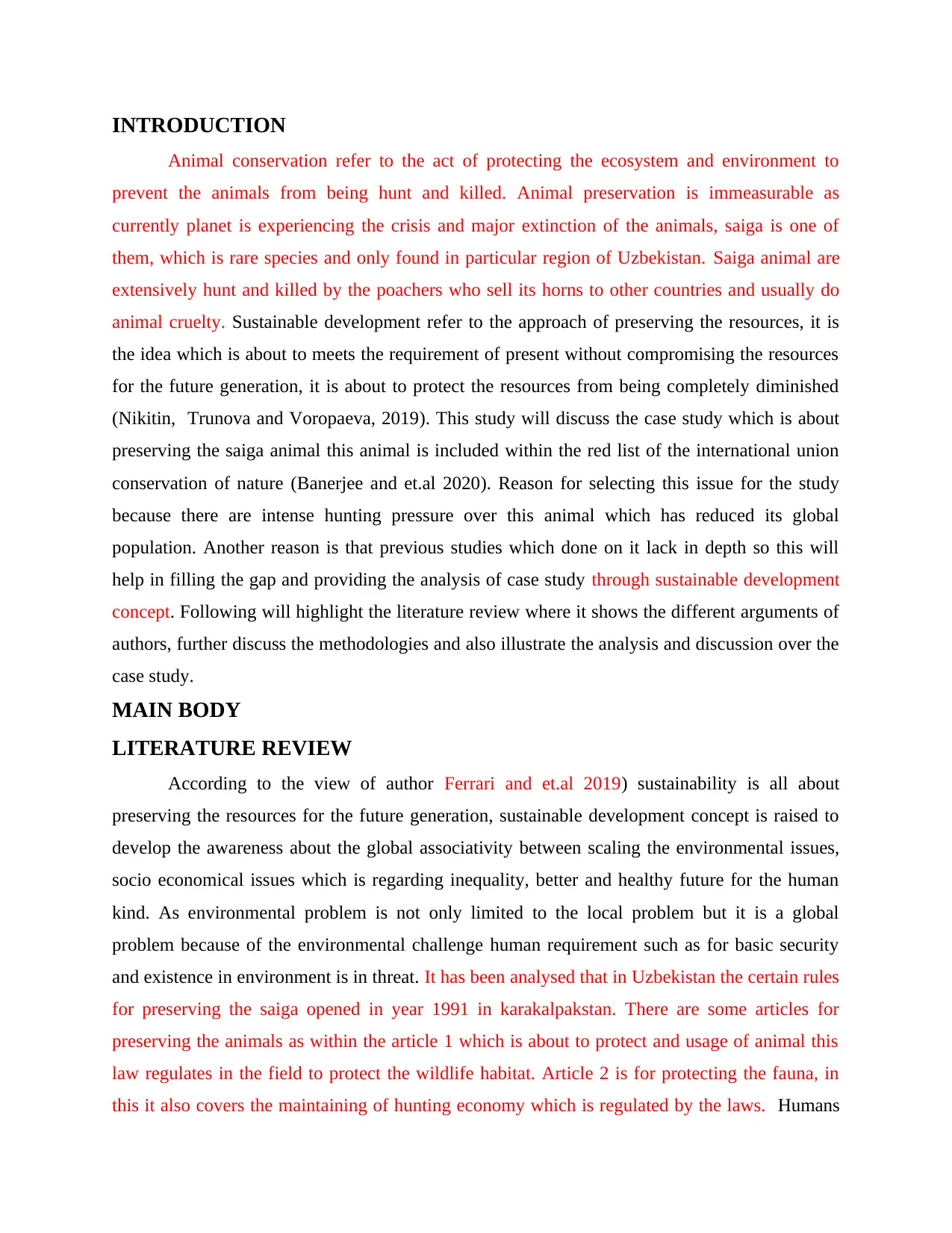
INTRODUCTION
Animal conservation refer to the act of protecting the ecosystem and environment to
prevent the animals from being hunt and killed. Animal preservation is immeasurable as
currently planet is experiencing the crisis and major extinction of the animals, saiga is one of
them, which is rare species and only found in particular region of Uzbekistan. Saiga animal are
extensively hunt and killed by the poachers who sell its horns to other countries and usually do
animal cruelty. Sustainable development refer to the approach of preserving the resources, it is
the idea which is about to meets the requirement of present without compromising the resources
for the future generation, it is about to protect the resources from being completely diminished
(Nikitin, Trunova and Voropaeva, 2019). This study will discuss the case study which is about
preserving the saiga animal this animal is included within the red list of the international union
conservation of nature (Banerjee and et.al 2020). Reason for selecting this issue for the study
because there are intense hunting pressure over this animal which has reduced its global
population. Another reason is that previous studies which done on it lack in depth so this will
help in filling the gap and providing the analysis of case study through sustainable development
concept. Following will highlight the literature review where it shows the different arguments of
authors, further discuss the methodologies and also illustrate the analysis and discussion over the
case study.
MAIN BODY
LITERATURE REVIEW
According to the view of author Ferrari and et.al 2019) sustainability is all about
preserving the resources for the future generation, sustainable development concept is raised to
develop the awareness about the global associativity between scaling the environmental issues,
socio economical issues which is regarding inequality, better and healthy future for the human
kind. As environmental problem is not only limited to the local problem but it is a global
problem because of the environmental challenge human requirement such as for basic security
and existence in environment is in threat. It has been analysed that in Uzbekistan the certain rules
for preserving the saiga opened in year 1991 in karakalpakstan. There are some articles for
preserving the animals as within the article 1 which is about to protect and usage of animal this
law regulates in the field to protect the wildlife habitat. Article 2 is for protecting the fauna, in
this it also covers the maintaining of hunting economy which is regulated by the laws. Humans
Animal conservation refer to the act of protecting the ecosystem and environment to
prevent the animals from being hunt and killed. Animal preservation is immeasurable as
currently planet is experiencing the crisis and major extinction of the animals, saiga is one of
them, which is rare species and only found in particular region of Uzbekistan. Saiga animal are
extensively hunt and killed by the poachers who sell its horns to other countries and usually do
animal cruelty. Sustainable development refer to the approach of preserving the resources, it is
the idea which is about to meets the requirement of present without compromising the resources
for the future generation, it is about to protect the resources from being completely diminished
(Nikitin, Trunova and Voropaeva, 2019). This study will discuss the case study which is about
preserving the saiga animal this animal is included within the red list of the international union
conservation of nature (Banerjee and et.al 2020). Reason for selecting this issue for the study
because there are intense hunting pressure over this animal which has reduced its global
population. Another reason is that previous studies which done on it lack in depth so this will
help in filling the gap and providing the analysis of case study through sustainable development
concept. Following will highlight the literature review where it shows the different arguments of
authors, further discuss the methodologies and also illustrate the analysis and discussion over the
case study.
MAIN BODY
LITERATURE REVIEW
According to the view of author Ferrari and et.al 2019) sustainability is all about
preserving the resources for the future generation, sustainable development concept is raised to
develop the awareness about the global associativity between scaling the environmental issues,
socio economical issues which is regarding inequality, better and healthy future for the human
kind. As environmental problem is not only limited to the local problem but it is a global
problem because of the environmental challenge human requirement such as for basic security
and existence in environment is in threat. It has been analysed that in Uzbekistan the certain rules
for preserving the saiga opened in year 1991 in karakalpakstan. There are some articles for
preserving the animals as within the article 1 which is about to protect and usage of animal this
law regulates in the field to protect the wildlife habitat. Article 2 is for protecting the fauna, in
this it also covers the maintaining of hunting economy which is regulated by the laws. Humans
⊘ This is a preview!⊘
Do you want full access?
Subscribe today to unlock all pages.

Trusted by 1+ million students worldwide
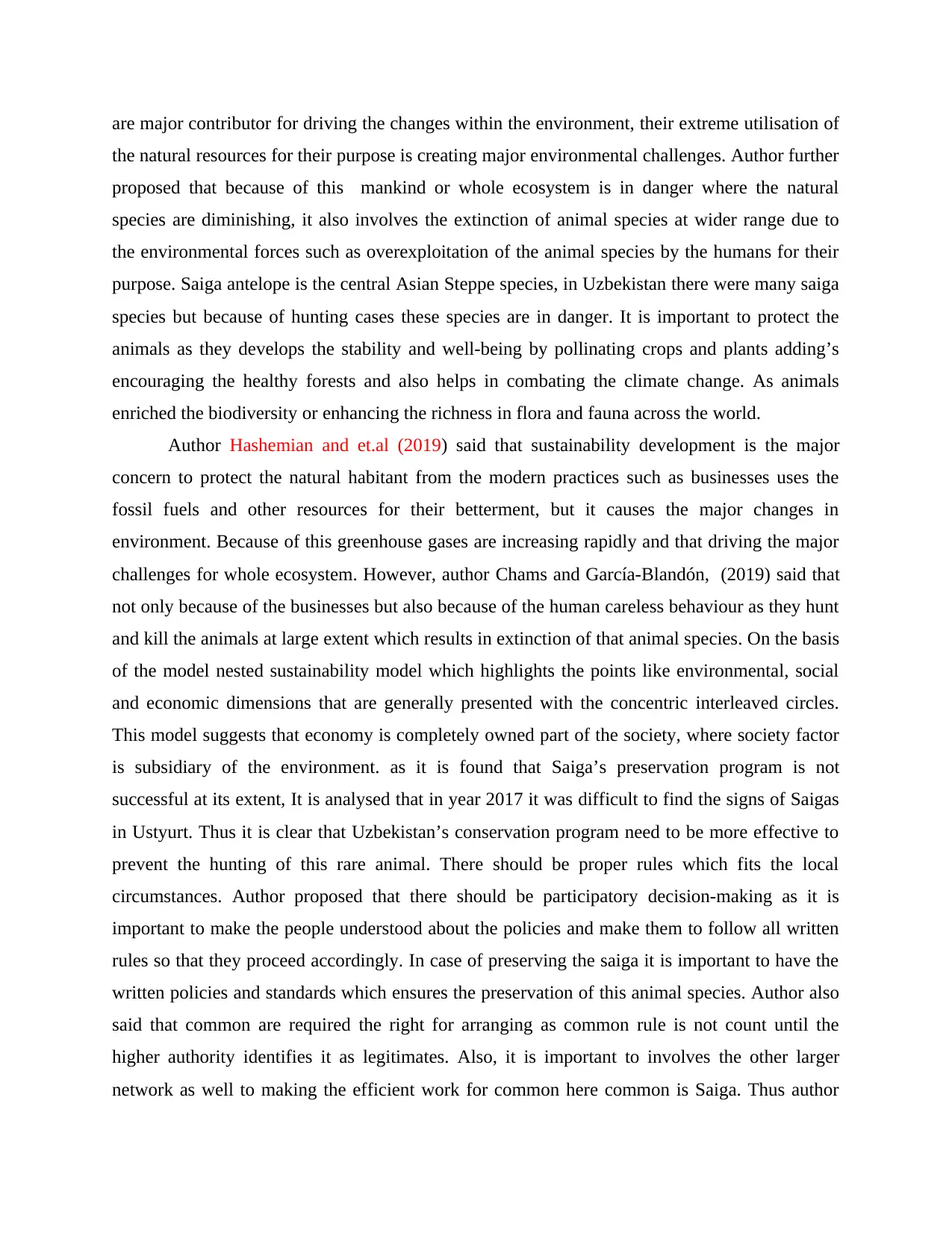
are major contributor for driving the changes within the environment, their extreme utilisation of
the natural resources for their purpose is creating major environmental challenges. Author further
proposed that because of this mankind or whole ecosystem is in danger where the natural
species are diminishing, it also involves the extinction of animal species at wider range due to
the environmental forces such as overexploitation of the animal species by the humans for their
purpose. Saiga antelope is the central Asian Steppe species, in Uzbekistan there were many saiga
species but because of hunting cases these species are in danger. It is important to protect the
animals as they develops the stability and well-being by pollinating crops and plants adding’s
encouraging the healthy forests and also helps in combating the climate change. As animals
enriched the biodiversity or enhancing the richness in flora and fauna across the world.
Author Hashemian and et.al (2019) said that sustainability development is the major
concern to protect the natural habitant from the modern practices such as businesses uses the
fossil fuels and other resources for their betterment, but it causes the major changes in
environment. Because of this greenhouse gases are increasing rapidly and that driving the major
challenges for whole ecosystem. However, author Chams and García-Blandón, (2019) said that
not only because of the businesses but also because of the human careless behaviour as they hunt
and kill the animals at large extent which results in extinction of that animal species. On the basis
of the model nested sustainability model which highlights the points like environmental, social
and economic dimensions that are generally presented with the concentric interleaved circles.
This model suggests that economy is completely owned part of the society, where society factor
is subsidiary of the environment. as it is found that Saiga’s preservation program is not
successful at its extent, It is analysed that in year 2017 it was difficult to find the signs of Saigas
in Ustyurt. Thus it is clear that Uzbekistan’s conservation program need to be more effective to
prevent the hunting of this rare animal. There should be proper rules which fits the local
circumstances. Author proposed that there should be participatory decision-making as it is
important to make the people understood about the policies and make them to follow all written
rules so that they proceed accordingly. In case of preserving the saiga it is important to have the
written policies and standards which ensures the preservation of this animal species. Author also
said that common are required the right for arranging as common rule is not count until the
higher authority identifies it as legitimates. Also, it is important to involves the other larger
network as well to making the efficient work for common here common is Saiga. Thus author
the natural resources for their purpose is creating major environmental challenges. Author further
proposed that because of this mankind or whole ecosystem is in danger where the natural
species are diminishing, it also involves the extinction of animal species at wider range due to
the environmental forces such as overexploitation of the animal species by the humans for their
purpose. Saiga antelope is the central Asian Steppe species, in Uzbekistan there were many saiga
species but because of hunting cases these species are in danger. It is important to protect the
animals as they develops the stability and well-being by pollinating crops and plants adding’s
encouraging the healthy forests and also helps in combating the climate change. As animals
enriched the biodiversity or enhancing the richness in flora and fauna across the world.
Author Hashemian and et.al (2019) said that sustainability development is the major
concern to protect the natural habitant from the modern practices such as businesses uses the
fossil fuels and other resources for their betterment, but it causes the major changes in
environment. Because of this greenhouse gases are increasing rapidly and that driving the major
challenges for whole ecosystem. However, author Chams and García-Blandón, (2019) said that
not only because of the businesses but also because of the human careless behaviour as they hunt
and kill the animals at large extent which results in extinction of that animal species. On the basis
of the model nested sustainability model which highlights the points like environmental, social
and economic dimensions that are generally presented with the concentric interleaved circles.
This model suggests that economy is completely owned part of the society, where society factor
is subsidiary of the environment. as it is found that Saiga’s preservation program is not
successful at its extent, It is analysed that in year 2017 it was difficult to find the signs of Saigas
in Ustyurt. Thus it is clear that Uzbekistan’s conservation program need to be more effective to
prevent the hunting of this rare animal. There should be proper rules which fits the local
circumstances. Author proposed that there should be participatory decision-making as it is
important to make the people understood about the policies and make them to follow all written
rules so that they proceed accordingly. In case of preserving the saiga it is important to have the
written policies and standards which ensures the preservation of this animal species. Author also
said that common are required the right for arranging as common rule is not count until the
higher authority identifies it as legitimates. Also, it is important to involves the other larger
network as well to making the efficient work for common here common is Saiga. Thus author
Paraphrase This Document
Need a fresh take? Get an instant paraphrase of this document with our AI Paraphraser
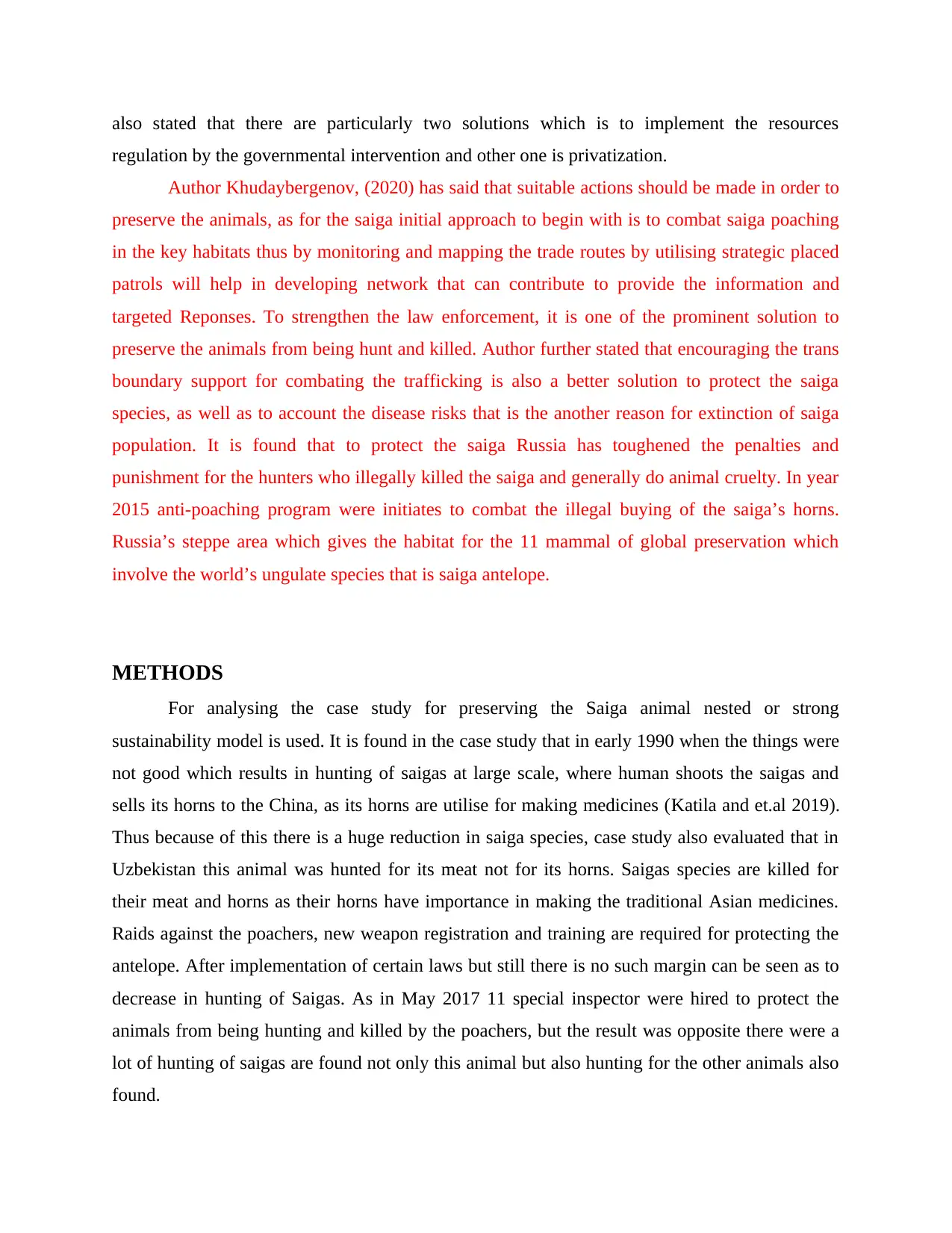
also stated that there are particularly two solutions which is to implement the resources
regulation by the governmental intervention and other one is privatization.
Author Khudaybergenov, (2020) has said that suitable actions should be made in order to
preserve the animals, as for the saiga initial approach to begin with is to combat saiga poaching
in the key habitats thus by monitoring and mapping the trade routes by utilising strategic placed
patrols will help in developing network that can contribute to provide the information and
targeted Reponses. To strengthen the law enforcement, it is one of the prominent solution to
preserve the animals from being hunt and killed. Author further stated that encouraging the trans
boundary support for combating the trafficking is also a better solution to protect the saiga
species, as well as to account the disease risks that is the another reason for extinction of saiga
population. It is found that to protect the saiga Russia has toughened the penalties and
punishment for the hunters who illegally killed the saiga and generally do animal cruelty. In year
2015 anti-poaching program were initiates to combat the illegal buying of the saiga’s horns.
Russia’s steppe area which gives the habitat for the 11 mammal of global preservation which
involve the world’s ungulate species that is saiga antelope.
METHODS
For analysing the case study for preserving the Saiga animal nested or strong
sustainability model is used. It is found in the case study that in early 1990 when the things were
not good which results in hunting of saigas at large scale, where human shoots the saigas and
sells its horns to the China, as its horns are utilise for making medicines (Katila and et.al 2019).
Thus because of this there is a huge reduction in saiga species, case study also evaluated that in
Uzbekistan this animal was hunted for its meat not for its horns. Saigas species are killed for
their meat and horns as their horns have importance in making the traditional Asian medicines.
Raids against the poachers, new weapon registration and training are required for protecting the
antelope. After implementation of certain laws but still there is no such margin can be seen as to
decrease in hunting of Saigas. As in May 2017 11 special inspector were hired to protect the
animals from being hunting and killed by the poachers, but the result was opposite there were a
lot of hunting of saigas are found not only this animal but also hunting for the other animals also
found.
regulation by the governmental intervention and other one is privatization.
Author Khudaybergenov, (2020) has said that suitable actions should be made in order to
preserve the animals, as for the saiga initial approach to begin with is to combat saiga poaching
in the key habitats thus by monitoring and mapping the trade routes by utilising strategic placed
patrols will help in developing network that can contribute to provide the information and
targeted Reponses. To strengthen the law enforcement, it is one of the prominent solution to
preserve the animals from being hunt and killed. Author further stated that encouraging the trans
boundary support for combating the trafficking is also a better solution to protect the saiga
species, as well as to account the disease risks that is the another reason for extinction of saiga
population. It is found that to protect the saiga Russia has toughened the penalties and
punishment for the hunters who illegally killed the saiga and generally do animal cruelty. In year
2015 anti-poaching program were initiates to combat the illegal buying of the saiga’s horns.
Russia’s steppe area which gives the habitat for the 11 mammal of global preservation which
involve the world’s ungulate species that is saiga antelope.
METHODS
For analysing the case study for preserving the Saiga animal nested or strong
sustainability model is used. It is found in the case study that in early 1990 when the things were
not good which results in hunting of saigas at large scale, where human shoots the saigas and
sells its horns to the China, as its horns are utilise for making medicines (Katila and et.al 2019).
Thus because of this there is a huge reduction in saiga species, case study also evaluated that in
Uzbekistan this animal was hunted for its meat not for its horns. Saigas species are killed for
their meat and horns as their horns have importance in making the traditional Asian medicines.
Raids against the poachers, new weapon registration and training are required for protecting the
antelope. After implementation of certain laws but still there is no such margin can be seen as to
decrease in hunting of Saigas. As in May 2017 11 special inspector were hired to protect the
animals from being hunting and killed by the poachers, but the result was opposite there were a
lot of hunting of saigas are found not only this animal but also hunting for the other animals also
found.
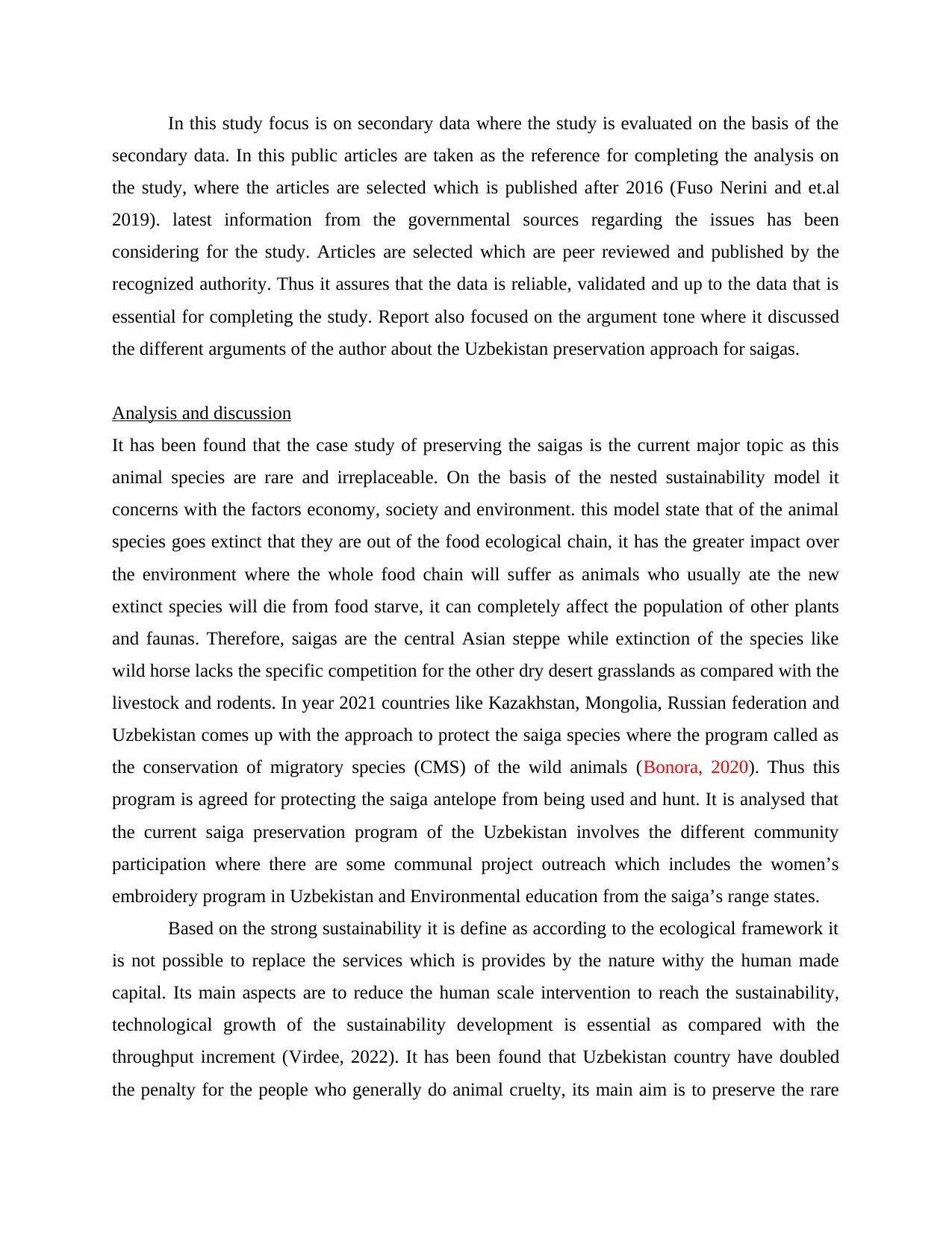
In this study focus is on secondary data where the study is evaluated on the basis of the
secondary data. In this public articles are taken as the reference for completing the analysis on
the study, where the articles are selected which is published after 2016 (Fuso Nerini and et.al
2019). latest information from the governmental sources regarding the issues has been
considering for the study. Articles are selected which are peer reviewed and published by the
recognized authority. Thus it assures that the data is reliable, validated and up to the data that is
essential for completing the study. Report also focused on the argument tone where it discussed
the different arguments of the author about the Uzbekistan preservation approach for saigas.
Analysis and discussion
It has been found that the case study of preserving the saigas is the current major topic as this
animal species are rare and irreplaceable. On the basis of the nested sustainability model it
concerns with the factors economy, society and environment. this model state that of the animal
species goes extinct that they are out of the food ecological chain, it has the greater impact over
the environment where the whole food chain will suffer as animals who usually ate the new
extinct species will die from food starve, it can completely affect the population of other plants
and faunas. Therefore, saigas are the central Asian steppe while extinction of the species like
wild horse lacks the specific competition for the other dry desert grasslands as compared with the
livestock and rodents. In year 2021 countries like Kazakhstan, Mongolia, Russian federation and
Uzbekistan comes up with the approach to protect the saiga species where the program called as
the conservation of migratory species (CMS) of the wild animals (Bonora, 2020). Thus this
program is agreed for protecting the saiga antelope from being used and hunt. It is analysed that
the current saiga preservation program of the Uzbekistan involves the different community
participation where there are some communal project outreach which includes the women’s
embroidery program in Uzbekistan and Environmental education from the saiga’s range states.
Based on the strong sustainability it is define as according to the ecological framework it
is not possible to replace the services which is provides by the nature withy the human made
capital. Its main aspects are to reduce the human scale intervention to reach the sustainability,
technological growth of the sustainability development is essential as compared with the
throughput increment (Virdee, 2022). It has been found that Uzbekistan country have doubled
the penalty for the people who generally do animal cruelty, its main aim is to preserve the rare
secondary data. In this public articles are taken as the reference for completing the analysis on
the study, where the articles are selected which is published after 2016 (Fuso Nerini and et.al
2019). latest information from the governmental sources regarding the issues has been
considering for the study. Articles are selected which are peer reviewed and published by the
recognized authority. Thus it assures that the data is reliable, validated and up to the data that is
essential for completing the study. Report also focused on the argument tone where it discussed
the different arguments of the author about the Uzbekistan preservation approach for saigas.
Analysis and discussion
It has been found that the case study of preserving the saigas is the current major topic as this
animal species are rare and irreplaceable. On the basis of the nested sustainability model it
concerns with the factors economy, society and environment. this model state that of the animal
species goes extinct that they are out of the food ecological chain, it has the greater impact over
the environment where the whole food chain will suffer as animals who usually ate the new
extinct species will die from food starve, it can completely affect the population of other plants
and faunas. Therefore, saigas are the central Asian steppe while extinction of the species like
wild horse lacks the specific competition for the other dry desert grasslands as compared with the
livestock and rodents. In year 2021 countries like Kazakhstan, Mongolia, Russian federation and
Uzbekistan comes up with the approach to protect the saiga species where the program called as
the conservation of migratory species (CMS) of the wild animals (Bonora, 2020). Thus this
program is agreed for protecting the saiga antelope from being used and hunt. It is analysed that
the current saiga preservation program of the Uzbekistan involves the different community
participation where there are some communal project outreach which includes the women’s
embroidery program in Uzbekistan and Environmental education from the saiga’s range states.
Based on the strong sustainability it is define as according to the ecological framework it
is not possible to replace the services which is provides by the nature withy the human made
capital. Its main aspects are to reduce the human scale intervention to reach the sustainability,
technological growth of the sustainability development is essential as compared with the
throughput increment (Virdee, 2022). It has been found that Uzbekistan country have doubled
the penalty for the people who generally do animal cruelty, its main aim is to preserve the rare
⊘ This is a preview!⊘
Do you want full access?
Subscribe today to unlock all pages.

Trusted by 1+ million students worldwide
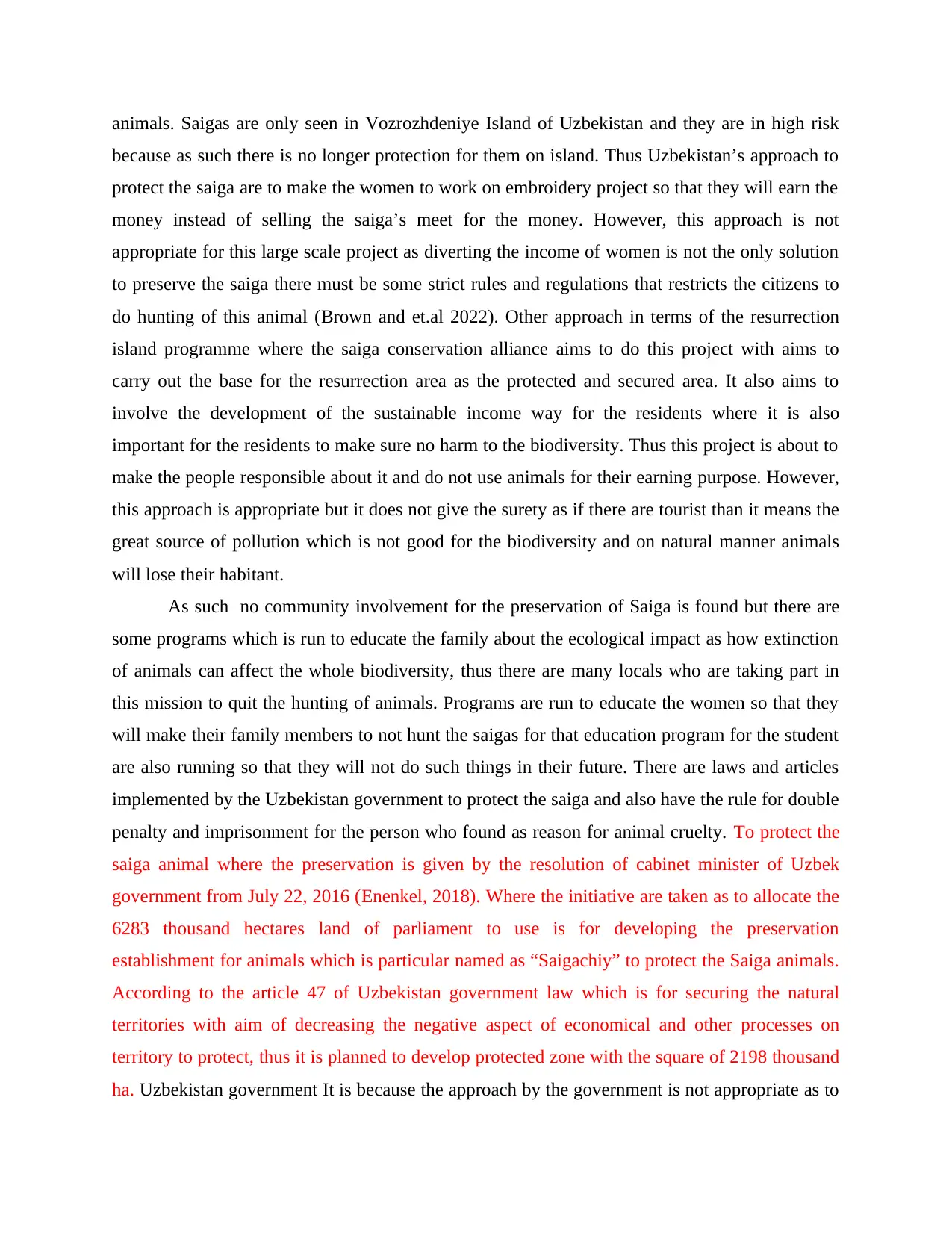
animals. Saigas are only seen in Vozrozhdeniye Island of Uzbekistan and they are in high risk
because as such there is no longer protection for them on island. Thus Uzbekistan’s approach to
protect the saiga are to make the women to work on embroidery project so that they will earn the
money instead of selling the saiga’s meet for the money. However, this approach is not
appropriate for this large scale project as diverting the income of women is not the only solution
to preserve the saiga there must be some strict rules and regulations that restricts the citizens to
do hunting of this animal (Brown and et.al 2022). Other approach in terms of the resurrection
island programme where the saiga conservation alliance aims to do this project with aims to
carry out the base for the resurrection area as the protected and secured area. It also aims to
involve the development of the sustainable income way for the residents where it is also
important for the residents to make sure no harm to the biodiversity. Thus this project is about to
make the people responsible about it and do not use animals for their earning purpose. However,
this approach is appropriate but it does not give the surety as if there are tourist than it means the
great source of pollution which is not good for the biodiversity and on natural manner animals
will lose their habitant.
As such no community involvement for the preservation of Saiga is found but there are
some programs which is run to educate the family about the ecological impact as how extinction
of animals can affect the whole biodiversity, thus there are many locals who are taking part in
this mission to quit the hunting of animals. Programs are run to educate the women so that they
will make their family members to not hunt the saigas for that education program for the student
are also running so that they will not do such things in their future. There are laws and articles
implemented by the Uzbekistan government to protect the saiga and also have the rule for double
penalty and imprisonment for the person who found as reason for animal cruelty. To protect the
saiga animal where the preservation is given by the resolution of cabinet minister of Uzbek
government from July 22, 2016 (Enenkel, 2018). Where the initiative are taken as to allocate the
6283 thousand hectares land of parliament to use is for developing the preservation
establishment for animals which is particular named as “Saigachiy” to protect the Saiga animals.
According to the article 47 of Uzbekistan government law which is for securing the natural
territories with aim of decreasing the negative aspect of economical and other processes on
territory to protect, thus it is planned to develop protected zone with the square of 2198 thousand
ha. Uzbekistan government It is because the approach by the government is not appropriate as to
because as such there is no longer protection for them on island. Thus Uzbekistan’s approach to
protect the saiga are to make the women to work on embroidery project so that they will earn the
money instead of selling the saiga’s meet for the money. However, this approach is not
appropriate for this large scale project as diverting the income of women is not the only solution
to preserve the saiga there must be some strict rules and regulations that restricts the citizens to
do hunting of this animal (Brown and et.al 2022). Other approach in terms of the resurrection
island programme where the saiga conservation alliance aims to do this project with aims to
carry out the base for the resurrection area as the protected and secured area. It also aims to
involve the development of the sustainable income way for the residents where it is also
important for the residents to make sure no harm to the biodiversity. Thus this project is about to
make the people responsible about it and do not use animals for their earning purpose. However,
this approach is appropriate but it does not give the surety as if there are tourist than it means the
great source of pollution which is not good for the biodiversity and on natural manner animals
will lose their habitant.
As such no community involvement for the preservation of Saiga is found but there are
some programs which is run to educate the family about the ecological impact as how extinction
of animals can affect the whole biodiversity, thus there are many locals who are taking part in
this mission to quit the hunting of animals. Programs are run to educate the women so that they
will make their family members to not hunt the saigas for that education program for the student
are also running so that they will not do such things in their future. There are laws and articles
implemented by the Uzbekistan government to protect the saiga and also have the rule for double
penalty and imprisonment for the person who found as reason for animal cruelty. To protect the
saiga animal where the preservation is given by the resolution of cabinet minister of Uzbek
government from July 22, 2016 (Enenkel, 2018). Where the initiative are taken as to allocate the
6283 thousand hectares land of parliament to use is for developing the preservation
establishment for animals which is particular named as “Saigachiy” to protect the Saiga animals.
According to the article 47 of Uzbekistan government law which is for securing the natural
territories with aim of decreasing the negative aspect of economical and other processes on
territory to protect, thus it is planned to develop protected zone with the square of 2198 thousand
ha. Uzbekistan government It is because the approach by the government is not appropriate as to
Paraphrase This Document
Need a fresh take? Get an instant paraphrase of this document with our AI Paraphraser
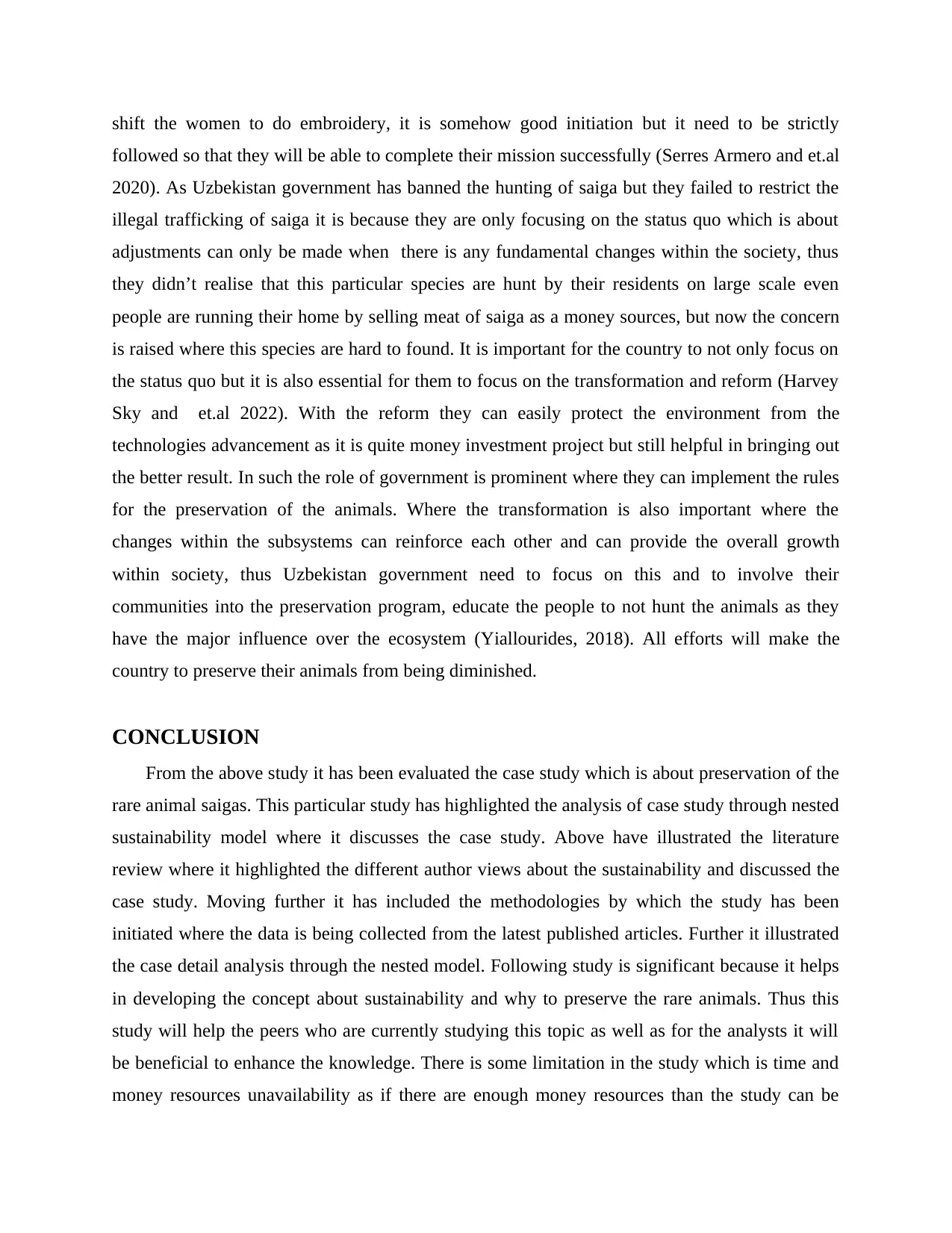
shift the women to do embroidery, it is somehow good initiation but it need to be strictly
followed so that they will be able to complete their mission successfully (Serres Armero and et.al
2020). As Uzbekistan government has banned the hunting of saiga but they failed to restrict the
illegal trafficking of saiga it is because they are only focusing on the status quo which is about
adjustments can only be made when there is any fundamental changes within the society, thus
they didn’t realise that this particular species are hunt by their residents on large scale even
people are running their home by selling meat of saiga as a money sources, but now the concern
is raised where this species are hard to found. It is important for the country to not only focus on
the status quo but it is also essential for them to focus on the transformation and reform (Harvey
Sky and et.al 2022). With the reform they can easily protect the environment from the
technologies advancement as it is quite money investment project but still helpful in bringing out
the better result. In such the role of government is prominent where they can implement the rules
for the preservation of the animals. Where the transformation is also important where the
changes within the subsystems can reinforce each other and can provide the overall growth
within society, thus Uzbekistan government need to focus on this and to involve their
communities into the preservation program, educate the people to not hunt the animals as they
have the major influence over the ecosystem (Yiallourides, 2018). All efforts will make the
country to preserve their animals from being diminished.
CONCLUSION
From the above study it has been evaluated the case study which is about preservation of the
rare animal saigas. This particular study has highlighted the analysis of case study through nested
sustainability model where it discusses the case study. Above have illustrated the literature
review where it highlighted the different author views about the sustainability and discussed the
case study. Moving further it has included the methodologies by which the study has been
initiated where the data is being collected from the latest published articles. Further it illustrated
the case detail analysis through the nested model. Following study is significant because it helps
in developing the concept about sustainability and why to preserve the rare animals. Thus this
study will help the peers who are currently studying this topic as well as for the analysts it will
be beneficial to enhance the knowledge. There is some limitation in the study which is time and
money resources unavailability as if there are enough money resources than the study can be
followed so that they will be able to complete their mission successfully (Serres Armero and et.al
2020). As Uzbekistan government has banned the hunting of saiga but they failed to restrict the
illegal trafficking of saiga it is because they are only focusing on the status quo which is about
adjustments can only be made when there is any fundamental changes within the society, thus
they didn’t realise that this particular species are hunt by their residents on large scale even
people are running their home by selling meat of saiga as a money sources, but now the concern
is raised where this species are hard to found. It is important for the country to not only focus on
the status quo but it is also essential for them to focus on the transformation and reform (Harvey
Sky and et.al 2022). With the reform they can easily protect the environment from the
technologies advancement as it is quite money investment project but still helpful in bringing out
the better result. In such the role of government is prominent where they can implement the rules
for the preservation of the animals. Where the transformation is also important where the
changes within the subsystems can reinforce each other and can provide the overall growth
within society, thus Uzbekistan government need to focus on this and to involve their
communities into the preservation program, educate the people to not hunt the animals as they
have the major influence over the ecosystem (Yiallourides, 2018). All efforts will make the
country to preserve their animals from being diminished.
CONCLUSION
From the above study it has been evaluated the case study which is about preservation of the
rare animal saigas. This particular study has highlighted the analysis of case study through nested
sustainability model where it discusses the case study. Above have illustrated the literature
review where it highlighted the different author views about the sustainability and discussed the
case study. Moving further it has included the methodologies by which the study has been
initiated where the data is being collected from the latest published articles. Further it illustrated
the case detail analysis through the nested model. Following study is significant because it helps
in developing the concept about sustainability and why to preserve the rare animals. Thus this
study will help the peers who are currently studying this topic as well as for the analysts it will
be beneficial to enhance the knowledge. There is some limitation in the study which is time and
money resources unavailability as if there are enough money resources than the study can be
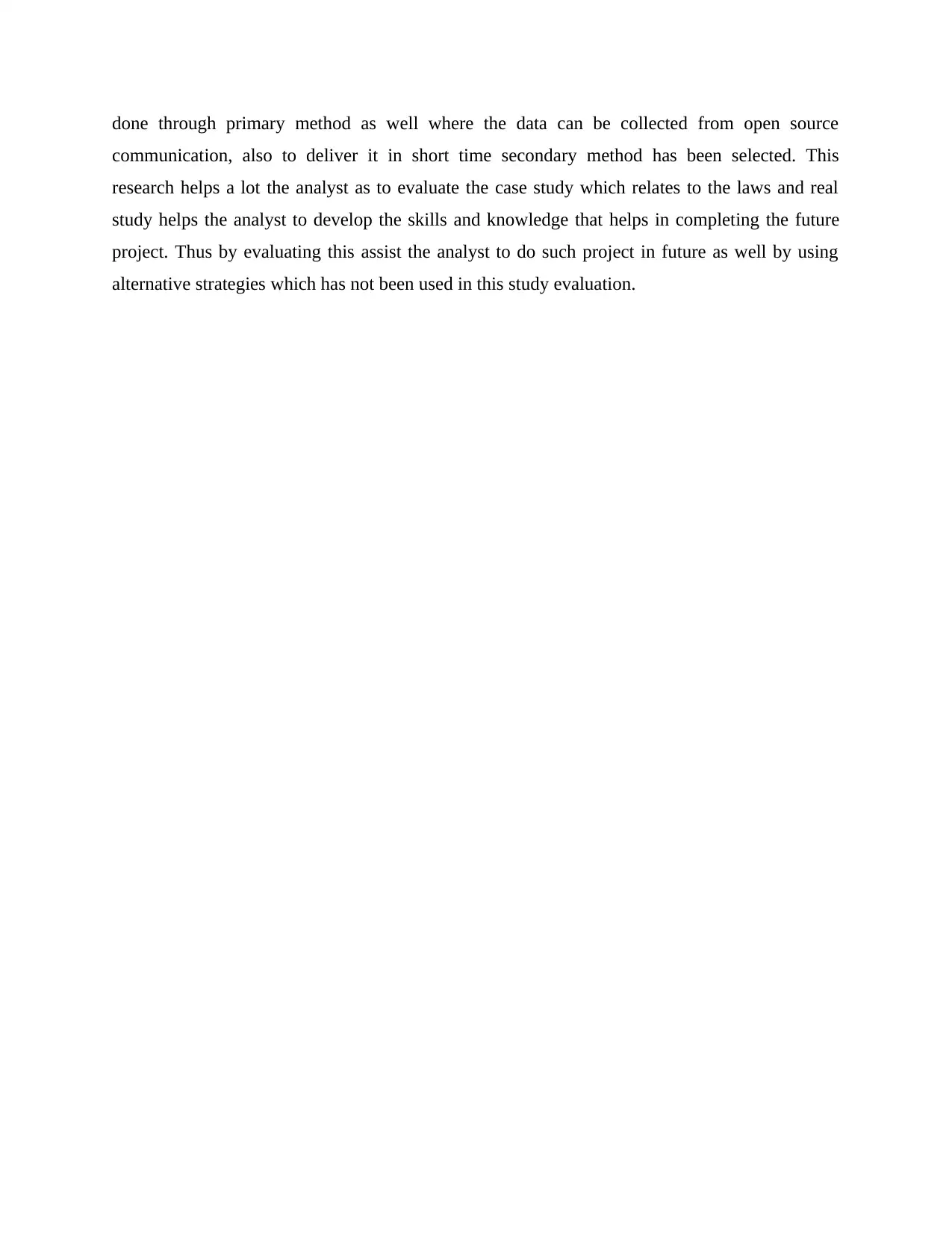
done through primary method as well where the data can be collected from open source
communication, also to deliver it in short time secondary method has been selected. This
research helps a lot the analyst as to evaluate the case study which relates to the laws and real
study helps the analyst to develop the skills and knowledge that helps in completing the future
project. Thus by evaluating this assist the analyst to do such project in future as well by using
alternative strategies which has not been used in this study evaluation.
communication, also to deliver it in short time secondary method has been selected. This
research helps a lot the analyst as to evaluate the case study which relates to the laws and real
study helps the analyst to develop the skills and knowledge that helps in completing the future
project. Thus by evaluating this assist the analyst to do such project in future as well by using
alternative strategies which has not been used in this study evaluation.
⊘ This is a preview!⊘
Do you want full access?
Subscribe today to unlock all pages.

Trusted by 1+ million students worldwide
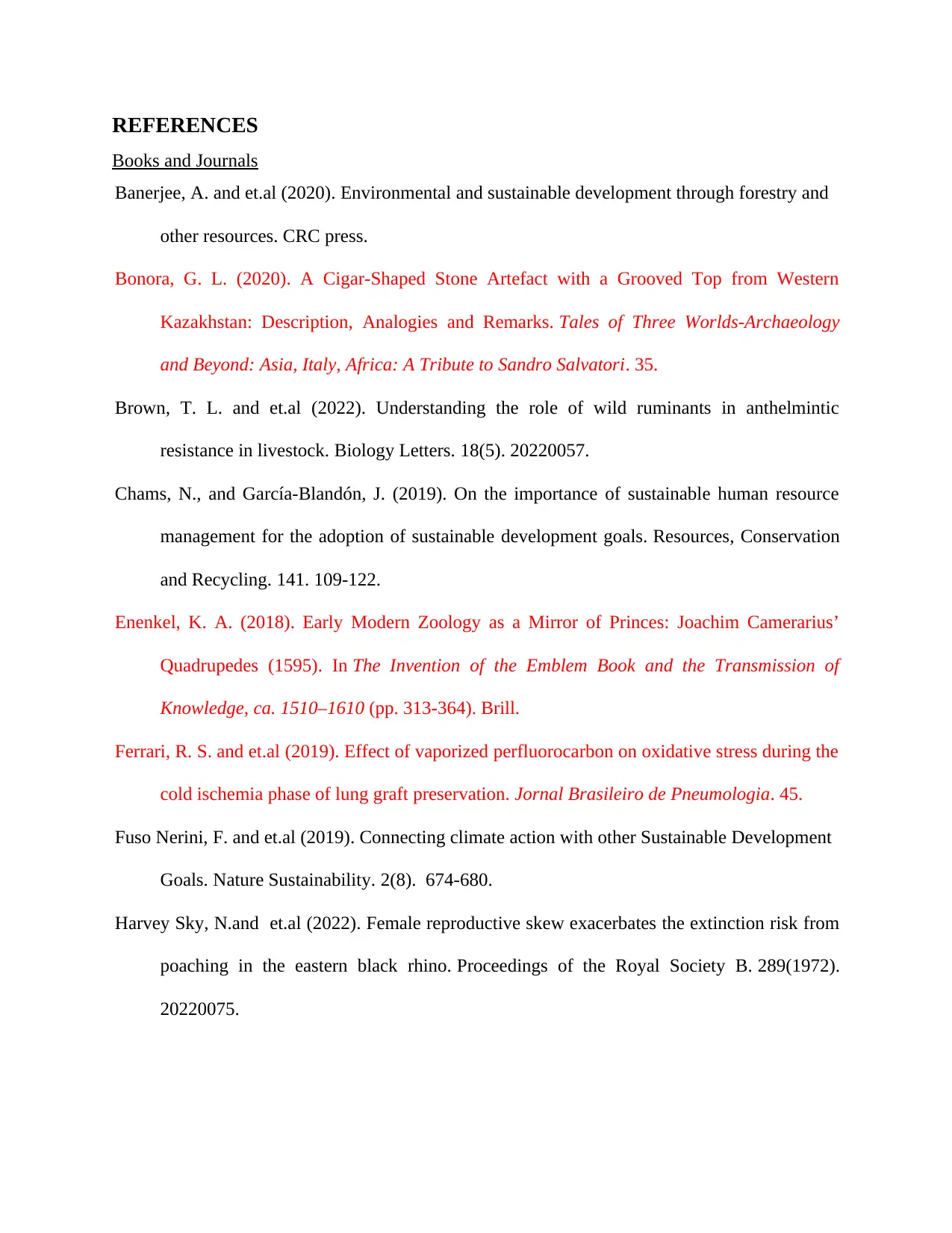
REFERENCES
Books and Journals
Banerjee, A. and et.al (2020). Environmental and sustainable development through forestry and
other resources. CRC press.
Bonora, G. L. (2020). A Cigar-Shaped Stone Artefact with a Grooved Top from Western
Kazakhstan: Description, Analogies and Remarks. Tales of Three Worlds-Archaeology
and Beyond: Asia, Italy, Africa: A Tribute to Sandro Salvatori. 35.
Brown, T. L. and et.al (2022). Understanding the role of wild ruminants in anthelmintic
resistance in livestock. Biology Letters. 18(5). 20220057.
Chams, N., and García-Blandón, J. (2019). On the importance of sustainable human resource
management for the adoption of sustainable development goals. Resources, Conservation
and Recycling. 141. 109-122.
Enenkel, K. A. (2018). Early Modern Zoology as a Mirror of Princes: Joachim Camerarius’
Quadrupedes (1595). In The Invention of the Emblem Book and the Transmission of
Knowledge, ca. 1510–1610 (pp. 313-364). Brill.
Ferrari, R. S. and et.al (2019). Effect of vaporized perfluorocarbon on oxidative stress during the
cold ischemia phase of lung graft preservation. Jornal Brasileiro de Pneumologia. 45.
Fuso Nerini, F. and et.al (2019). Connecting climate action with other Sustainable Development
Goals. Nature Sustainability. 2(8). 674-680.
Harvey Sky, N.and et.al (2022). Female reproductive skew exacerbates the extinction risk from
poaching in the eastern black rhino. Proceedings of the Royal Society B. 289(1972).
20220075.
Books and Journals
Banerjee, A. and et.al (2020). Environmental and sustainable development through forestry and
other resources. CRC press.
Bonora, G. L. (2020). A Cigar-Shaped Stone Artefact with a Grooved Top from Western
Kazakhstan: Description, Analogies and Remarks. Tales of Three Worlds-Archaeology
and Beyond: Asia, Italy, Africa: A Tribute to Sandro Salvatori. 35.
Brown, T. L. and et.al (2022). Understanding the role of wild ruminants in anthelmintic
resistance in livestock. Biology Letters. 18(5). 20220057.
Chams, N., and García-Blandón, J. (2019). On the importance of sustainable human resource
management for the adoption of sustainable development goals. Resources, Conservation
and Recycling. 141. 109-122.
Enenkel, K. A. (2018). Early Modern Zoology as a Mirror of Princes: Joachim Camerarius’
Quadrupedes (1595). In The Invention of the Emblem Book and the Transmission of
Knowledge, ca. 1510–1610 (pp. 313-364). Brill.
Ferrari, R. S. and et.al (2019). Effect of vaporized perfluorocarbon on oxidative stress during the
cold ischemia phase of lung graft preservation. Jornal Brasileiro de Pneumologia. 45.
Fuso Nerini, F. and et.al (2019). Connecting climate action with other Sustainable Development
Goals. Nature Sustainability. 2(8). 674-680.
Harvey Sky, N.and et.al (2022). Female reproductive skew exacerbates the extinction risk from
poaching in the eastern black rhino. Proceedings of the Royal Society B. 289(1972).
20220075.
Paraphrase This Document
Need a fresh take? Get an instant paraphrase of this document with our AI Paraphraser
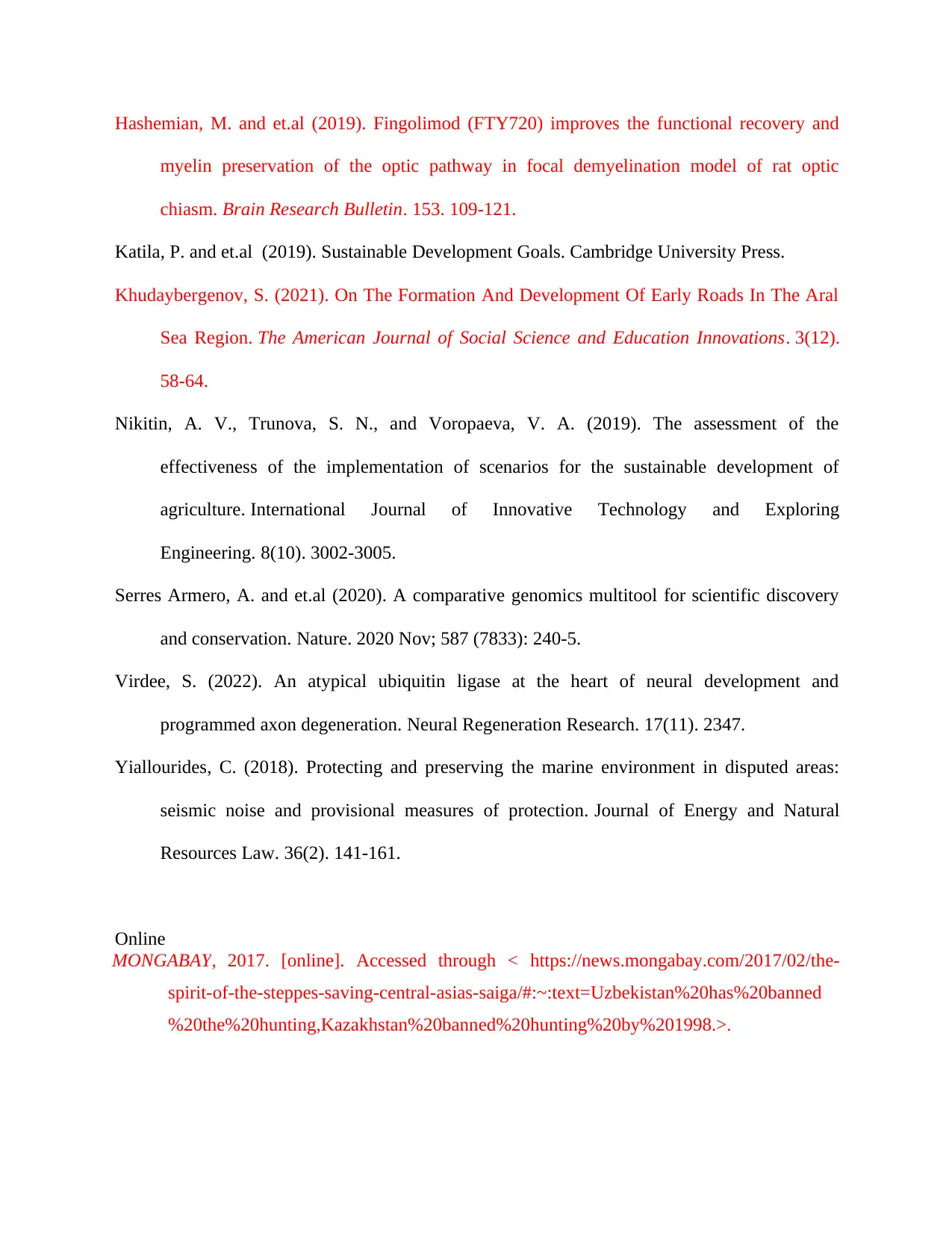
Hashemian, M. and et.al (2019). Fingolimod (FTY720) improves the functional recovery and
myelin preservation of the optic pathway in focal demyelination model of rat optic
chiasm. Brain Research Bulletin. 153. 109-121.
Katila, P. and et.al (2019). Sustainable Development Goals. Cambridge University Press.
Khudaybergenov, S. (2021). On The Formation And Development Of Early Roads In The Aral
Sea Region. The American Journal of Social Science and Education Innovations. 3(12).
58-64.
Nikitin, A. V., Trunova, S. N., and Voropaeva, V. A. (2019). The assessment of the
effectiveness of the implementation of scenarios for the sustainable development of
agriculture. International Journal of Innovative Technology and Exploring
Engineering. 8(10). 3002-3005.
Serres Armero, A. and et.al (2020). A comparative genomics multitool for scientific discovery
and conservation. Nature. 2020 Nov; 587 (7833): 240-5.
Virdee, S. (2022). An atypical ubiquitin ligase at the heart of neural development and
programmed axon degeneration. Neural Regeneration Research. 17(11). 2347.
Yiallourides, C. (2018). Protecting and preserving the marine environment in disputed areas:
seismic noise and provisional measures of protection. Journal of Energy and Natural
Resources Law. 36(2). 141-161.
Online
MONGABAY, 2017. [online]. Accessed through < https://news.mongabay.com/2017/02/the-
spirit-of-the-steppes-saving-central-asias-saiga/#:~:text=Uzbekistan%20has%20banned
%20the%20hunting,Kazakhstan%20banned%20hunting%20by%201998.>.
myelin preservation of the optic pathway in focal demyelination model of rat optic
chiasm. Brain Research Bulletin. 153. 109-121.
Katila, P. and et.al (2019). Sustainable Development Goals. Cambridge University Press.
Khudaybergenov, S. (2021). On The Formation And Development Of Early Roads In The Aral
Sea Region. The American Journal of Social Science and Education Innovations. 3(12).
58-64.
Nikitin, A. V., Trunova, S. N., and Voropaeva, V. A. (2019). The assessment of the
effectiveness of the implementation of scenarios for the sustainable development of
agriculture. International Journal of Innovative Technology and Exploring
Engineering. 8(10). 3002-3005.
Serres Armero, A. and et.al (2020). A comparative genomics multitool for scientific discovery
and conservation. Nature. 2020 Nov; 587 (7833): 240-5.
Virdee, S. (2022). An atypical ubiquitin ligase at the heart of neural development and
programmed axon degeneration. Neural Regeneration Research. 17(11). 2347.
Yiallourides, C. (2018). Protecting and preserving the marine environment in disputed areas:
seismic noise and provisional measures of protection. Journal of Energy and Natural
Resources Law. 36(2). 141-161.
Online
MONGABAY, 2017. [online]. Accessed through < https://news.mongabay.com/2017/02/the-
spirit-of-the-steppes-saving-central-asias-saiga/#:~:text=Uzbekistan%20has%20banned
%20the%20hunting,Kazakhstan%20banned%20hunting%20by%201998.>.
1 out of 11
Related Documents
Your All-in-One AI-Powered Toolkit for Academic Success.
+13062052269
info@desklib.com
Available 24*7 on WhatsApp / Email
![[object Object]](/_next/static/media/star-bottom.7253800d.svg)
Unlock your academic potential
Copyright © 2020–2025 A2Z Services. All Rights Reserved. Developed and managed by ZUCOL.





